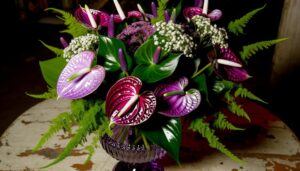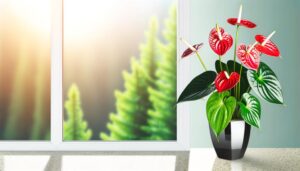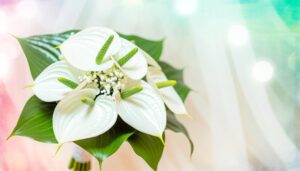Caring for Anthurium Dynamite Red: A Step-by-Step Guide
To care for your Anthurium Dynamite Red, place it in bright, indirect light, ideally near an east- or north-facing window. Maintain temperatures between 70-85°F and guarantee humidity levels are 70-80%.
Opt for a well-draining, organic-rich soil and water when the top inch feels dry. Make certain the pot has drainage holes to prevent waterlogging.
Regularly inspect for pests and use neem oil for treatment. Fertilize bi-weekly in spring and summer, reduce in autumn, and limit watering in winter.
For propagation, divide the root clump guaranteeing healthy root sections. Master these steps for a flourish of vibrant blooms and glossy foliage.

Key Takeaways
- Place the plant in bright, indirect light near east- or north-facing windows.
- Maintain room temperature between 70-85°F (21-29°C) and humidity levels between 70-80%.
- Use well-draining, organic-rich soil and ensure the pot has drainage holes.
- Water evenly, checking soil moisture to prevent waterlogging, and adjust watering based on the season.
- Examine leaves regularly for pests and use neem oil or insecticidal soap for control.
Understanding Your Anthurium Dynamite Red
Understanding your Anthurium Dynamite Red involves recognizing its unique characteristics, such as its vibrant red spathes and glossy green leaves, which require specific care and environmental conditions to flourish.
You'll notice that the spathes are waxy and heart-shaped, providing a striking contrast to its dark green foliage. Pay attention to the leaf veins; they're quite prominent and add to the plant's dramatic appearance.
To maintain this beauty, make sure the soil is well-draining and rich in organic matter. Don't forget to monitor the humidity levels, as this tropical plant thrives in higher humidity. Keep an eye on the root system too; healthy roots are white and firm.
A close relationship with your plant will help you identify and address any issues promptly.
Ideal Light Conditions
To guarantee your Anthurium Dynamite Red prospers, place it in bright, indirect light to mimic its natural understory habitat. Position it near east- or north-facing windows where it can receive ample filtered sunlight without direct exposure. Direct sunlight can scorch its leaves, leading to unsightly browning. Utilize sheer curtains if necessary to diffuse harsh rays.
If natural light is limited, consider using artificial grow lights, maintaining a distance of 12-18 inches to avoid overheating. Rotate your plant every few weeks to achieve even light distribution and balanced growth.
Observe the leaf color and texture: dark green leaves indicate insufficient light, while yellowing leaves suggest too much light. Adjust its position accordingly to maintain ideal conditions.
Temperature and Humidity Needs
Maintaining the right temperature and humidity levels is important for the health and vibrancy of your Anthurium Dynamite Red. Aim to keep the room temperature between 70-85°F (21-29°C) during the day, dropping no lower than 60°F (15°C) at night.
High humidity, ideally between 70-80%, is vital for this tropical plant. To achieve this, consider the following:
- Humidifier: Use a humidifier to maintain consistent moisture levels in the air.
- Misting: Regularly mist the leaves, but avoid over-wetting them to prevent fungal issues.
- Pebble Tray: Place the pot on a tray filled with water and pebbles to naturally increase humidity through evaporation.
These steps guarantee your Anthurium thrives, showcasing its stunning red blooms.
Choosing the Right Soil
Choosing the right soil for your Anthurium Dynamite Red involves ensuring a well-draining mix rich in organic matter to promote healthy root growth and prevent waterlogging.
Start with a blend that includes peat moss, pine bark, and perlite. Peat moss enhances moisture retention while still allowing airflow. Pine bark provides structure and aeration, preventing soil compaction. Perlite improves drainage, ensuring excess water flows away from the roots.
You can also incorporate orchid bark or charcoal to further enhance drainage. Avoid standard garden soil, as it's too dense and can suffocate the roots. Regularly check the soil's consistency; it should be light and crumbly.
Proper Watering Techniques
When watering your Anthurium Dynamite Red, make certain you provide enough moisture without allowing the soil to become waterlogged, as this can lead to root rot.
Here's how you can achieve that:
- Check Soil Moisture: Insert your finger about an inch into the soil. Water when the top inch feels dry, but the soil beneath is still moist.
- Water Evenly: Pour water evenly over the soil surface until it drains from the bottom. This guarantees the entire root system gets hydrated.
- Drain Excess Water: Guarantee your pot has drainage holes. Empty the saucer under the pot after watering to prevent standing water.
Fertilizing Your Plant
Now that you've mastered proper watering techniques, it's important to understand how to fertilize your Anthurium Dynamite Red to promote robust growth and vibrant blooms.
Use a balanced, water-soluble fertilizer with a ratio such as 20-20-20. Dilute the fertilizer to half-strength to prevent burning the roots. Apply it every 6-8 weeks during the growing season, from spring to early autumn.
Make sure the soil is moist before fertilizing to help distribute nutrients evenly. Avoid excessive fertilization, as this can lead to salt build-up and damage your plant.
If you notice yellowing leaves or stunted growth, it might be a sign of nutrient deficiency. Adjust your fertilization schedule accordingly to keep your Anthurium healthy and thriving.
Pruning and Deadheading
To sustain your Anthurium Dynamite Red, make sure you have sharp, sterilized pruning shears for effective trimming and disease prevention.
Focus on deadheading spent blooms regularly to promote new growth and sustain the plant's vibrancy.
Always prune damaged or yellowing leaves to enhance overall plant health and aesthetics.
Essential Pruning Tools
Your pruning toolkit should include sharp, sterilized shears, a pair of bypass pruners, and a small pair of scissors for precise deadheading of your Anthurium Dynamite Red. Ensuring your tools are clean and sharp is essential to prevent disease and make clean cuts.
Here's what you need:
- Sterilized Shears: Ideal for removing larger stems and leaves.
- Bypass Pruners: Perfect for cutting through thicker stems without crushing them.
- Small Scissors: Best for detailed work and deadheading spent blooms.
Deadheading Best Practices
Deadheading your Anthurium Dynamite Red involves carefully removing spent blooms to encourage new growth and maintain the plant's aesthetic appeal.
Start by identifying faded flowers; they'll appear wilted or discolored. Using sterilized pruning shears, trim the stem about half an inch above the nearest healthy leaf node. This minimizes the risk of infection and promotes strong regrowth.
Perform deadheading regularly, ideally once a month, to stimulate continuous blooming. Always inspect the plant for any yellowing leaves or signs of disease, removing these promptly.
Repotting Guidelines
Repotting your Anthurium Dynamite Red requires careful attention to timing and soil composition to achieve optimal growth and health. You'll know it's time to repot when roots start poking out of the drainage holes or the plant appears root-bound.
Follow these steps:
- Timing: Repot during the spring or early summer when the plant is most robust.
- Soil Mix: Use a well-draining mix of equal parts orchid bark, peat, and perlite to provide the right balance of aeration and moisture retention.
- Pot Size: Choose a pot that's one size larger, making sure it has ample drainage holes to prevent waterlogging.
This meticulous approach ensures your Anthurium thrives and continues to display its stunning dynamite red flowers.
Managing Common Pests
To manage common pests on your Anthurium Dynamite Red, start by identifying signs of infestation, such as discolored leaves or tiny insects.
Regularly inspect your plant for aphids, spider mites, and mealybugs.
For natural pest control, use insecticidal soap or neem oil, ensuring all affected areas are thoroughly treated.
Identifying Pest Infestations
Regularly inspecting your Anthurium Dynamite Red for signs of pest infestations is essential, as common pests like spider mites, aphids, and mealybugs can quickly damage the plant if not promptly managed. Look for:
- Discolored or spotted leaves: Spider mites leave tiny yellow or white spots on the leaves.
- Sticky residue: Aphids secrete a sticky substance called honeydew, which attracts mold.
- Cotton-like clumps: Mealybugs appear as white, cottony clusters on stems and leaves.
Examine the undersides of leaves where pests often hide. Utilize a magnifying glass to spot tiny invaders.
If you see any signs, act quickly to prevent further damage. Remember, early detection makes treatment easier and more effective, ensuring your plant stays vibrant and healthy.
Natural Pest Control
Biological controls, such as introducing predatory insects like ladybugs and lacewings, can effectively manage common pests on your Anthurium Dynamite Red without the use of harsh chemicals. Ladybugs are voracious aphid eaters, while lacewings target a wider range of pests, including mealybugs and spider mites.
Release these beneficial insects in the evening to prevent them from flying away. Keep your Anthurium in a location with good air circulation and humidity to deter pest populations. For added protection, use neem oil or insecticidal soap as a natural deterrent. Apply these treatments every two weeks, ensuring full coverage of the leaves and stems.
Regularly inspect your plant to catch and address any infestations early.
Preventing Diseases
Maintaining proper air circulation and humidity levels is crucial in preventing fungal infections in Anthurium Dynamite Red plants. You should prune any overcrowded leaves to guarantee air can flow freely around the plant.
Avoid overwatering by letting the top inch of soil dry out between watering sessions. To keep your Anthurium healthy, follow these steps:
- Ventilation: Use a small fan to enhance air circulation around your plants.
- Humidity: Maintain a humidity level of 60-80% using a humidifier or pebble tray.
- Sanitation: Regularly clean leaves with a damp cloth to eliminate dust and prevent disease buildup.
Seasonal Care Tips
Adapting your Anthurium Dynamite Red's care routine with each season guarantees peak growth and vibrant blooms year-round.
In spring and summer, increase watering frequency, making sure the soil remains moist but not waterlogged. Fertilize bi-weekly with a balanced, water-soluble fertilizer to support growth.
Come autumn, reduce watering slightly, allowing the top inch of soil to dry out between waterings. Lower the feeding to once a month.
During winter, minimize watering further, keeping the soil just barely moist, and suspend fertilization altogether.
Guarantee your plant receives bright, indirect light throughout the year, adjusting its position as daylight changes. Maintain indoor temperatures between 65-80°F and avoid drafts to keep your Anthurium thriving through all seasons.
Propagation Methods
To expand your Anthurium Dynamite Red collection or share its beauty with others, mastering propagation methods is key. You'll find success using these tried-and-true techniques:
- Division:
Gently remove the plant from its pot and separate the root clumps. Verify each section has a healthy root system and at least one growth node. Replant in fresh soil.
- Stem Cuttings:
Snip a healthy stem with a few leaves and aerial roots. Place the cutting in water or a moist perlite mix until roots develop, then transfer to soil.
- Offsets:
Look for small offshoots or pups at the base of the plant. Carefully detach and pot them separately, making certain they've sufficient roots.
Conclusion
By following these steps, you'll guarantee your Anthurium Dynamite Red thrives, dazzling with its vivid blooms.
Remember, consistent care is the key. Think of your plant as a living, breathing partner in your home's ecosystem—nurture it, and it will reward you.
Stay observant, adapt to its needs, and you'll cultivate a stunning, healthy anthurium that's the envy of any plant enthusiast.
Your diligence transforms care into a vibrant, flourishing masterpiece.






